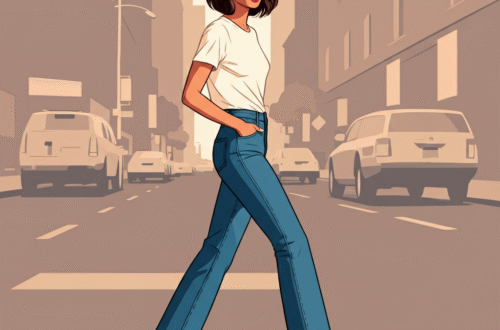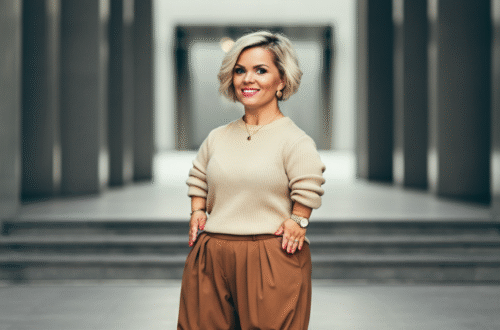Having a petite body is a unique trait that opens up a world of fashion possibilities. It’s not about being a certain weight or size; it’s all about height. If you are 5’4″ or under, you are part of the petite community. Understanding your proportions and how to dress for your frame can transform your style and boost your confidence. This guide will explore everything you need to know about celebrating and styling a petite body, from finding the right clothes to embracing your unique shape with confidence.
Key Takeaways
- Petite is About Height: Being petite refers to a height of 5’4″ (163 cm) or shorter, not a specific weight or body size.
- Proportions are Key: The main goal of petite styling is to create flattering proportions and elongate the figure.
- Fit is Everything: Off-the-rack clothing often requires tailoring for a perfect fit on a petite body.
- Strategic Styling: Techniques like wearing monochromatic outfits, V-necks, and high-waisted bottoms can create the illusion of height.
- Confidence is Your Best Accessory: Embracing your petite body and feeling good in what you wear is the most important style rule.
What Exactly is a Petite Body?
The term “petite” in the fashion world can be confusing. Many people mistakenly believe it refers to being skinny or wearing a small size. However, the true definition of a petite body is based solely on height. Anyone, regardless of their shape or weight, who is 5’4″ or under is considered petite. This means you can be a size 2 or a size 16 and still have a petite body.
The fashion industry designs standard clothing for a model who is typically around 5’8″. This means that for someone with a petite body, the proportions of regular-sized clothing are often incorrect. Sleeves may be too long, the waist might not sit in the right place, and the shoulder seams could droop. This is why understanding that petite is a height category is the first step toward building a wardrobe that truly fits and flatters you. It opens the door to shopping in dedicated petite sections or learning how to select regular-sized pieces that work for your frame.
The Common Challenges of Dressing a Petite Body
Dressing a petite body comes with a unique set of challenges that taller individuals might not face. Since standard clothing is designed for a taller frame, petites often find that garments simply don’t fit correctly. A major issue is length. Trousers, jeans, and skirts are almost always too long, requiring hemming or rolling, which can disrupt the original design. Similarly, the sleeves on jackets, blouses, and sweaters often extend past the wrist.
Beyond length, proportional issues are a significant hurdle. For a petite body, the torso length, inseam, and rise of pants are shorter. A dress with a defined waist may hit at the hips instead. The knee placement on pants might be too low, and the shoulders of a blazer can be too wide. These fit problems can make you feel like you’re swimming in your clothes, which can overwhelm your frame and make you appear shorter. Finding brands that cater specifically to a petite body or investing in a good tailor becomes essential.
Creating the Illusion of Height
One of the most popular styling goals for those with a petite body is to create the illusion of a taller, more elongated silhouette. This can be achieved through clever fashion choices that draw the eye upward and create a continuous vertical line. Mastering these techniques can make a significant difference in how your outfits look and feel.
The Power of Vertical Lines
Vertical lines are a petite person’s best friend. They naturally guide the eye up and down, which helps to lengthen your frame. You can incorporate vertical lines into your wardrobe with pinstriped trousers, ribbed sweaters, or jackets with long lapels. Even a simple detail like a row of buttons on a shirt or a long necklace can create this elongating effect. Avoid bold horizontal stripes, especially wide ones, as they can have the opposite effect, making you appear wider and shorter. For more style inspiration, you can find great tips on blogs like the truefashionstory.com Blog.
The Magic of Monochrome
Wearing a single color from head to toe, known as monochromatic dressing, is one of the most effective ways to look taller. This creates an unbroken vertical line that visually stretches your petite body. You don’t have to stick to just black; you can achieve this look with any color, including neutrals like navy, cream, and gray, or even bold shades like red or cobalt blue. Playing with different textures within the same color family, such as a silk camisole with a cashmere cardigan, can add interest and sophistication to your monochromatic outfit.
Essential Wardrobe Staples for a Petite Body
Building a functional and stylish wardrobe starts with a foundation of essential pieces that fit your petite body perfectly. These staples are versatile, timeless, and can be mixed and matched to create countless outfits. Investing in high-quality versions of these items will ensure you always have something flattering to wear.
- High-Waisted Bottoms: High-waisted pants, skirts, and jeans make your legs appear longer by raising your natural waistline.
- Cropped Jackets: Jackets that end at or slightly above your natural waist help to define it and prevent your torso from looking shorter.
- V-Neck Tops: The V-shape neckline elongates your neck and torso, drawing the eye upward.
- Well-Fitted Blazer: A structured blazer with sharp shoulders can add definition to your frame. Look for petite-specific fits to ensure the shoulders and sleeve length are correct.
- Pointed-Toe Shoes: Pointed flats, heels, or boots extend the line of your leg, making you appear taller. Nude-colored shoes are particularly effective.
- A-Line Skirts and Dresses: This silhouette cinches at the waist and gently flares out, creating a flattering shape without overwhelming a petite body.
The Importance of Proportions
For a petite body, dressing is all about playing with proportions to create a balanced and harmonious look. The goal is to avoid being overwhelmed by your clothes and instead wear them in a way that flatters your natural frame. Understanding the “rule of thirds” can be a game-changer. This style principle suggests that outfits are most visually appealing when they are divided into thirds. For example, you can pair a top that covers one-third of your body with bottoms that cover the remaining two-thirds. A high-waisted pant with a tucked-in top achieves this perfectly.
Another key aspect of proportion is scale. When choosing prints and accessories, opt for smaller-scaled versions. Large, bold prints can easily overwhelm a petite body, while smaller, more delicate patterns like micro-florals or thin stripes are more proportionate. The same logic applies to accessories. A huge handbag can look out of place, whereas a medium-sized crossbody or a chic clutch will complement your frame beautifully.
Necklines that Flatter a Petite Frame
The right neckline can do wonders for elongating your upper body. V-necks are universally flattering for a petite body because they create a vertical line that draws the eye downwards, making your torso and neck appear longer. Scoop necks and square necklines also work well by showing off your collarbones and opening up the chest area. Asymmetrical necklines can add a modern touch while also creating a lengthening diagonal line. It’s generally best to avoid high necklines like turtlenecks unless they are form-fitting and paired with other elongating elements.
Petite vs. Regular Sizing: What’s the Difference?
Understanding the specific differences between petite and regular sizing is crucial for finding clothes that truly fit. It’s not just about making things shorter; petite sizing adjusts the entire garment’s proportions.
|
Feature |
Regular Sizing |
Petite Sizing |
|---|---|---|
|
Height Basis |
Designed for 5’5″ and above |
Designed for 5’4″ and below |
|
Sleeve Length |
Standard length |
Shorter to fit the arm |
|
Torso Length |
Standard from shoulder to waist |
Shorter from shoulder to waist |
|
Shoulder Width |
Wider seam-to-seam |
Narrower to prevent drooping |
|
Inseam |
Longer pant leg |
Shorter pant leg |
|
Detail Placement |
Knees, pockets, darts placed lower |
Knees, pockets, darts placed higher |
As the table shows, every aspect of a petite garment is scaled down to fit a shorter frame. This is why simply hemming a regular-sized pair of pants doesn’t always solve the fit issue; the rise and knee placement will still be off for a petite body.
Finding the Right Fit: The Role of a Tailor
Even with the growing availability of petite-friendly brands, a good tailor is an invaluable asset for anyone with a petite body. Tailoring can take a good-fitting piece and make it perfect. Simple adjustments like hemming pants or shortening sleeves are common, but a skilled tailor can do much more. They can raise the waistline of a dress, take in the shoulders of a jacket, or add darts to a blouse for a more defined shape.
Don’t be afraid to buy a regular-sized item you love if it has potential. As long as the shoulders fit well (as this is the most difficult part to alter), many other adjustments can be made. Investing a small amount in tailoring can make an affordable piece of clothing look expensive and custom-made for your petite body. This ensures your clothes are flattering you in the best way possible.
Conclusion: Confidence is Key
Styling a petite body is less about following rigid rules and more about understanding what makes you feel your best. While tips for elongating your frame and balancing proportions are helpful guides, the most important element of any outfit is confidence. Wear the colors, prints, and styles that you love and that reflect your personality. Experiment with different looks to discover what makes you feel powerful and comfortable in your own skin. Your height is a part of who you are, and with the right knowledge, you can build a wardrobe that celebrates your petite body in every way.
Frequently Asked Questions (FAQ)
Q1: Can I wear oversized clothing if I have a petite body?
A: Yes, you can! The key is balance. If you’re wearing an oversized sweater or blazer, pair it with slim-fitting bottoms like skinny jeans or leggings to maintain your shape. Avoid wearing baggy clothes from head to toe, as this can overwhelm your frame.
Q2: What are the best shoes for a petite body?
A: Shoes with a pointed toe, whether they are flats, heels, or boots, are excellent for elongating the leg line. Heels will always add height, but you don’t need stilettos. A low block heel or kitten heel works well. Choosing shoes that match your skin tone (nude) or the color of your pants also creates a seamless, lengthening effect.
Q3: Are there any prints I should avoid as a petite person?
A: It’s best to be cautious with large, oversized prints, as they can overwhelm a smaller frame. Opt for small-to-medium-sized patterns like ditsy florals, small polka dots, or thin stripes. If you love a bold print, try incorporating it in a smaller dose, like on a scarf or a top paired with solid-colored bottoms.
Q4: Does being petite mean I have to wear kids’ clothes?
A: Not at all. While the teen section can sometimes be a source for basics, petite sizing is specifically designed for an adult woman’s body, just scaled down in proportion. Petite clothing accounts for bust, waist, and hip measurements in a way that children’s clothing does not.
Q5: How can I find good brands for my petite body?
A: Many mainstream retailers now have dedicated petite sections, including ASOS, Banana Republic, J.Crew, and Ann Taylor. There are also brands that specialize in petite clothing. Exploring online and reading reviews from other petite shoppers can help you discover new brands that fit your style and body.





